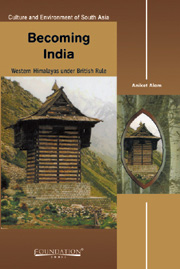Book contents
- Frontmatter
- Contents
- Preface
- Glossary
- Map
- Chapter 1 The Geography of the Western Himalayas
- Chapter 2 Political Economy of the Western Himalayas: Early Nineteenth Century
- Chapter 3 The Foundations of British Rule: Hill State, Hill Station, Land Settlement and Monetisation
- Chapter 4 Peasant Rebellions and Royal Reconciliation: British Rule inside the Hill States
- Chapter 5 Social Movements during British Rule
- Chapter 6 After Independence
- Conclusion
- Bibliography
- Index
Chapter 2 - Political Economy of the Western Himalayas: Early Nineteenth Century
Published online by Cambridge University Press: 26 October 2011
- Frontmatter
- Contents
- Preface
- Glossary
- Map
- Chapter 1 The Geography of the Western Himalayas
- Chapter 2 Political Economy of the Western Himalayas: Early Nineteenth Century
- Chapter 3 The Foundations of British Rule: Hill State, Hill Station, Land Settlement and Monetisation
- Chapter 4 Peasant Rebellions and Royal Reconciliation: British Rule inside the Hill States
- Chapter 5 Social Movements during British Rule
- Chapter 6 After Independence
- Conclusion
- Bibliography
- Index
Summary
This chapter is divided into two parts, the sphere of production and the sphere of politics, which could also be called the processes and institutions of appropriation. It begins by an attempt at quantifying the productive percentage of the population of the Western Himalayas, in reference to the specificity of their village communities. This would enable a better understanding of the nature of production, the social context of appropriation and the working of political processes, which were strongly conditioned by the unique constraints that were imposed by a combination of geography (discussed in the previous chapter) and demography. The discussion on production first deals with the forms of labour in the various productive processes and moves on to study these different productive processes separately – agriculture, pastoralism, artisan manufacture and trade. The discussion on the sphere of politics focuses on the two main methods of surplus appropriation employed – begar labour and rent-in-kind, as well as the constraints on accumulation that can be identified. The two main centres of power, the lineage-based clans and the Hill State, and their interrelations with each other will subsequently be studied.
It will be one of the contentions of this book that the interdependence of production, the demographic and geographic constraints on the intensification and expansion of production and the exceptional marginality, both economic and spatial, of monetisation, even among the trading groups, holds the key to understanding the uniqueness of the Western Himalayan political economy before the intrusion of the British.
- Type
- Chapter
- Information
- Becoming IndiaWestern Himalayas under British Rule, pp. 32 - 96Publisher: Foundation BooksPrint publication year: 2007



